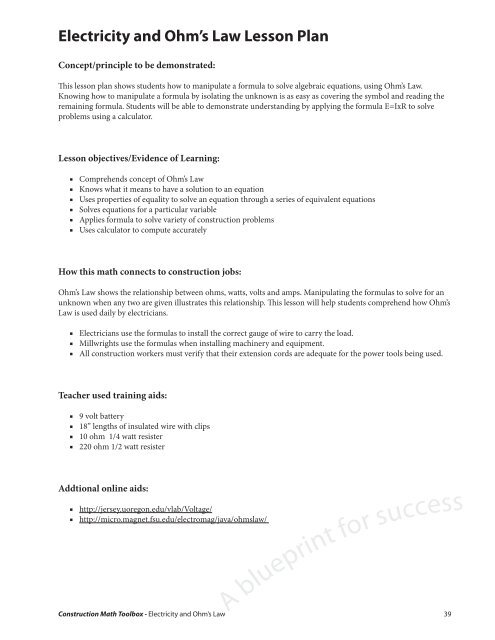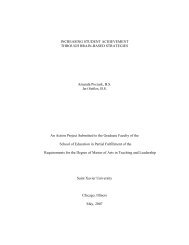Electricity and Ohm's Law Lesson Plan - Renton Technical College
Electricity and Ohm's Law Lesson Plan - Renton Technical College
Electricity and Ohm's Law Lesson Plan - Renton Technical College
You also want an ePaper? Increase the reach of your titles
YUMPU automatically turns print PDFs into web optimized ePapers that Google loves.
<strong>Electricity</strong> <strong>and</strong> Ohm’s <strong>Law</strong> <strong>Lesson</strong> <strong>Plan</strong><br />
Concept/principle to be demonstrated:<br />
Th is lesson plan shows students how to manipulate a formula to solve algebraic equations, using Ohm’s <strong>Law</strong>.<br />
Knowing how to manipulate a formula by isolating the unknown is as easy as covering the symbol <strong>and</strong> reading the<br />
remaining formula. Students will be able to demonstrate underst<strong>and</strong>ing by applying the formula E=IxR to solve<br />
problems using a calculator.<br />
<strong>Lesson</strong> objectives/Evidence of Learning:<br />
■ Comprehends concept of Ohm’s <strong>Law</strong><br />
■ Knows what it means to have a solution to an equation<br />
■ Uses properties of equality to solve an equation through a series of equivalent equations<br />
■ Solves equations for a particular variable<br />
■ Applies formula to solve variety of construction problems<br />
■ Uses calculator to compute accurately<br />
How this math connects to construction jobs:<br />
Ohm’s <strong>Law</strong> shows the relationship between ohms, watts, volts <strong>and</strong> amps. Manipulating the formulas to solve for an<br />
unknown when any two are given illustrates this relationship. Th is lesson will help students comprehend how Ohm’s<br />
<strong>Law</strong> is used daily by electricians.<br />
■ Electricians use the formulas to install the correct gauge of wire to carry the load.<br />
■ Millwrights use the formulas when installing machinery <strong>and</strong> equipment.<br />
■ All construction workers must verify that their extension cords are adequate for the power tools being used.<br />
Teacher used training aids:<br />
■ 9 volt battery<br />
■ 18” lengths of insulated wire with clips<br />
■ 10 ohm 1/4 watt resister<br />
■ 220 ohm 1/2 watt resister<br />
Addtional online aids:<br />
■ http://jersey.uoregon.edu/vlab/Voltage/<br />
■ http://micro.magnet.fsu.edu/electromag/java/ohmslaw/<br />
Construction Math Toolbox - <strong>Electricity</strong> <strong>and</strong> Ohm’s <strong>Law</strong><br />
39
Materials needed per student:<br />
■ Pencil<br />
■ Calculator with √ key & memory +/- functions<br />
■ <strong>Electricity</strong> <strong>and</strong> Ohm’s <strong>Law</strong> Worksheets<br />
■ <strong>Electricity</strong> <strong>and</strong> Ohm’s <strong>Law</strong> Example Problem h<strong>and</strong>out<br />
■ Formulas, Equations, <strong>and</strong> <strong>Law</strong>s h<strong>and</strong>out <strong>and</strong> two Ohm’s <strong>Law</strong> h<strong>and</strong>outs<br />
Terms:<br />
■ ( I ) Current is what flows on a wire or conductor like water flowing down a river. Current flows from points<br />
of high voltage to points of low voltage on the surface of a conductor. Current is measured in (A) amperes or<br />
amps.<br />
■ ( E ) Voltage is the difference in electrical potential between two points in a circuit. It’s the push or pressure<br />
behind current flow through a circuit, <strong>and</strong> is measured in (E) volts.<br />
■ ( R ) Resistance determines how much current will flow through a component. Resistors are used to control<br />
voltage <strong>and</strong> current levels. A very high resistance allows a small amount of current to flow. A very low<br />
resistance allows a large amount of current to flow. Resistance is measured in ohms.<br />
■ ( P ) Power is the amount of current times the voltage level at a given point measured in wattage or watts.<br />
<strong>Lesson</strong> Introduction:<br />
Ohms law, sometimes more correctly called Ohm’s <strong>Law</strong>, named after Mr. Georg Ohm, mathematician <strong>and</strong> physicist<br />
born 1789 <strong>and</strong> died 1854 in Bavaria, defines the relationship between power, voltage, current <strong>and</strong> resistance. These<br />
basic electrical units apply to direct current, or alternating current. Ohm’s <strong>Law</strong> is the foundation of electronics<br />
<strong>and</strong> electricity. These formulae are very easy to learn <strong>and</strong> are used extensively by electricians. Without a thorough<br />
underst<strong>and</strong>ing of “Ohm’s <strong>Law</strong>” an electrician would either design or troubleshoot even the simplest of electronic or<br />
electrical circuits. Ohm established in the late 1820’s that if a voltage was applied to a resistance then “current would<br />
flow <strong>and</strong> then power would be consumed”.<br />
<strong>Lesson</strong> Components:<br />
1. Draw on white board <strong>and</strong> explain:<br />
Ohm’s <strong>Law</strong> power consumption through a resistance<br />
Some practical every day examples of this basic rule are: base board heaters, electric frying pans, toasters<br />
<strong>and</strong> electric light bulbs. The heater consumes power producing heat for warmth, the frying pan consumes<br />
power producing heat for general cooking, the toaster consumes power producing heat for cooking toast,<br />
<strong>and</strong> the electric light bulb consumes power producing heat <strong>and</strong> more important light. A further example is<br />
an electric hot water system. All are examples of Ohm’s <strong>Law</strong> at its most basic.<br />
40 Construction Center of Excellence-<strong>Renton</strong> <strong>Technical</strong> <strong>College</strong>
2. Current is directly proportional to voltage. If voltage is increased by a given percentage, current increase<br />
by the same percentage. If the voltage is decreased by a given percentage, current decreases by the same<br />
percentage.<br />
3. Current is inversely proportional to resistance. An increase in resistance results in a decrease in current.<br />
A decrease in resistance results in an increase in current. It is important to note that resistance cannot be<br />
changed by changing voltage or current. Resistance in a circuit is a physical constant. Resistance in a circuit<br />
can only be changed by changing components or resistors rated at more or fewer ohms.<br />
4. Draw the following on the board:<br />
I = Current<br />
Show students how easy the formula is to use by covering the desired value<br />
<strong>and</strong> solving the equation<br />
5. For the following examples, voltage is E with an assigned a value of 12V, Current is I <strong>and</strong> is 2 amperes while<br />
resistance is R of 6 ohms. Note that “*” means multiply by, while “/” means divide by.<br />
a. For voltage [E = I x R] (COVER “E” WITH HAND)<br />
1. E (volts) = I (current) x R (resistance) OR<br />
2. 12 volts = 2 amperes x 6 ohms<br />
b. For current [I = E / R] (COVER “I” WITH HAND)<br />
1. I (current) = E (volts) / R (resistance) OR<br />
2. 2 amperes = 12 volts / 6 ohms<br />
c. For resistance [R = E / I] (COVER “R” WITH HAND)<br />
1. R (resistance) = E (volts) / I (current) OR<br />
2. 6 ohms = 12 volts / 2 amperes<br />
Another way to look at the relationships between (P) power, (E) voltage, (I) current, <strong>and</strong> (R) resistance is: One<br />
ohm is the resistance value through which one volt will maintain a current of one ampere.<br />
E = I x R Ohm’s <strong>Law</strong> with letter symbols<br />
Voltage = current x resistance Ohm’s <strong>Law</strong> formula with electrical quantities<br />
Volts = amps x ohms Ohm’s <strong>Law</strong> formula with units of measure<br />
V = A x Ohm’s <strong>Law</strong> formula with unit symbols<br />
Construction Math Toolbox - <strong>Electricity</strong> <strong>and</strong> Ohm’s <strong>Law</strong><br />
�<br />
E = Voltage<br />
� �<br />
R = Resistance<br />
41
6. Demonstration for determining amps (current):<br />
a. Show a 9 volt battery, a 10 ohm resistor <strong>and</strong> two wires with clips.<br />
b. Ask the students what the current (amps) will be.<br />
c. Correct answer is: 9 volts (E) / 10 ohms = 0.9 amps<br />
d. Ask the students if the circuit will work.<br />
e. Connect the circuit.<br />
f. Wait a minute for the resistor to smoke <strong>and</strong> smell.<br />
g. Disconnect <strong>and</strong> ask what happened.<br />
h. Show students the package (1/4 watt)<br />
i. Watts (P) are power.<br />
j. Reconnect circuit using 220 ohm resistor. Wait <strong>and</strong> watch.<br />
For power:<br />
P = E 2 / R OR Power = 24 watts = 122 volts / 6 ohms<br />
Also P = I 2 x R OR Power = 24 watts = 22 amperes x 6 ohms<br />
Also P = E x I OR Power = 24 watts = 12 volts x 2 amperes<br />
That’s all you need for Ohm’s <strong>Law</strong> - remember just two formulas:<br />
■ For voltage: E = I x R<br />
■ For power: P = E 2 / R<br />
7. Why does this work?<br />
8. Review relationship of the formula for voltage, resistance <strong>and</strong> current<br />
a. E=I x R<br />
b. R=E/I<br />
c. I= E/R<br />
9. H<strong>and</strong> out calculators, worksheet <strong>and</strong> examples pages, having students complete worksheet in teams.<br />
42 Construction Center of Excellence-<strong>Renton</strong> <strong>Technical</strong> <strong>College</strong>
<strong>Electricity</strong> <strong>and</strong> Ohm’s <strong>Law</strong> Worksheets<br />
Problem #1<br />
A 110 volt wall outlet supplies power to a strobe light with a resistance of 2200 ohms. How much current is flowing<br />
through the strobe light?<br />
Choose your answer below<br />
1. 0.5 amps<br />
2. 2.0 amps<br />
3. 0.05 amps<br />
4. 1.0 amps<br />
Problem #2<br />
A CD player with a resistance of 40 ohms has a current of 0.1 amps flowing through it. Sketch the circuit diagram<br />
<strong>and</strong> calculate how many volts supply the CD player.<br />
Choose your answer below<br />
1. 0.0025 volts<br />
2. 4.0 volts<br />
3. 10.0 volts<br />
4. 400.0 volts<br />
Problem #3<br />
�������<br />
�����<br />
A 120-volt power source supplies a lamp with a resistance of 192 ohms. What is the current flow of the circuit?<br />
Construction Math Toolbox - <strong>Electricity</strong> <strong>and</strong> Ohm’s <strong>Law</strong><br />
Name ______________________________<br />
43
Problem #4<br />
What is the resistance of the circuit conductors when the conductor voltage drop is 3 volts <strong>and</strong> the current flowing<br />
through the conductors is 100 amperes?<br />
Problem #5<br />
Given: I = 15A, R = 2 , find E<br />
Problem #6<br />
Given: E = 250V, R = 5 , find I<br />
Problem #7<br />
Given: E = 100V, I = 0.01A, find R<br />
Construction Math Toolbox - <strong>Electricity</strong> <strong>and</strong> Ohm’s <strong>Law</strong><br />
45
<strong>Electricity</strong> <strong>and</strong> Ohm’s <strong>Law</strong> Worksheets<br />
Problem #1<br />
A 110 volt wall outlet supplies power to a strobe light with a resistance of 2200 ohms. How much current is flowing<br />
through the strobe light?<br />
Choose your answer below<br />
1. 0.5 amps<br />
2. 2.0 amps<br />
3. 0.05 amps<br />
4. 1.0 amps<br />
Problem #2<br />
Construction Math Toolbox - <strong>Electricity</strong> <strong>and</strong> Ohm’s <strong>Law</strong><br />
E = I x R 110 = I x 2200<br />
110/2200 = I I = 0.05 amps<br />
A CD player with a resistance of 40 ohms has a current of 0.1 amps flowing through it. Sketch the circuit diagram<br />
<strong>and</strong> calculate how many volts supply the CD player.<br />
Choose your answer below<br />
1. 0.0025 volts<br />
2. 4.0 volts<br />
3. 10.0 volts<br />
4. 400.0 volts<br />
Problem #3<br />
�������<br />
�����<br />
E = ??<br />
I = 0.1<br />
amps<br />
A 120-volt power source supplies a lamp with a resistance of 192 ohms. What is the current flow of the circuit?<br />
E = I x R E = 120 volts R = 192<br />
Replace known values in sentence: 120 = I x 192<br />
Divide both sides by 192: 120/192 = I I = 0.625<br />
Check answer: 120 = 0.625 x 192<br />
KEY<br />
R = 40<br />
ohms<br />
E = I x R E = 0.1 x 40 E = 4.0 volts<br />
47
Problem #4<br />
What is the resistance of the circuit conductors when the conductor voltage drop is 3 volts <strong>and</strong> the current flowing<br />
through the conductors is 100 amperes?<br />
E = I x R E = 3 volts I = 100 amps<br />
Replace known values in sentence: 3 = 100 x R<br />
Divide both sides by 100: 3/100 = R R = 0.03 Ohms<br />
Check answer: 3 = 100 x 0.03<br />
Problem #5<br />
Given: I = 15A, R = 2 , find E<br />
E = I x R<br />
Replace known values in sentence: E = 15 x 2<br />
Complete multiplication: E = 30<br />
Check answer: 30 = 15 x 2<br />
Problem #6<br />
Given: E = 250V, R = 5 , find I<br />
E = I x R<br />
Replace known values in sentence: 250 = I x 5<br />
Divide both sides by 5: 250/5 = I I = 50 amps<br />
Check answer: 250 = 50 x 5<br />
Problem #7<br />
Given: E = 100V, I = 0.01A, find R<br />
E = I x R<br />
Replace known values in sentence: 100 = 0.01 x R<br />
Divide both sides by 0.01: 100/0.01 = R R = 10,000 Ohms<br />
Check answer: 100 = 0.01 x 10,000<br />
Construction Math Toolbox - <strong>Electricity</strong> <strong>and</strong> Ohm’s <strong>Law</strong><br />
KEY<br />
49
E = Voltage<br />
<strong>Electricity</strong> <strong>and</strong> Ohm’s <strong>Law</strong> Example Problem<br />
Example Problem:<br />
A nine volt battery supplies power to a cordless curling iron with a resistance<br />
of 18 ohms. How much current is flowing through the curling iron?<br />
����������<br />
�������<br />
Solution: OHM'S LAW E = I x R<br />
1.) Since E (Voltage) <strong>and</strong> R (Resistance) are<br />
known, solve for I (Current) by dividing both<br />
sides of the equation by R.<br />
E = I x R<br />
R R<br />
2.) The R's on the right h<strong>and</strong> side of the<br />
equation cancel. This will isolate I.<br />
E = I x R<br />
R R<br />
3.) I is then left in terms of E <strong>and</strong> R. E = I<br />
R<br />
4.) Substitute in the values for E (Voltage) <strong>and</strong> R<br />
(Resistance).<br />
9 = I<br />
18<br />
5.) Solve for I (Current). I = 0.5 amps<br />
Construction Math Toolbox - <strong>Electricity</strong> <strong>and</strong> Ohm’s <strong>Law</strong><br />
I = Current<br />
R = Resistance<br />
51
Construction Math Toolbox - <strong>Electricity</strong> <strong>and</strong> Ohm’s <strong>Law</strong><br />
FORMULAS, EQUATIONS & LAWS<br />
Symbolic:<br />
E =VOLTS ~or~ (V = VOLTS)<br />
P =WATTS ~or~ (W = WATTS)<br />
R = OHMS ~or~ (R = RESISTANCE)<br />
I =AMPERES ~or~ (A = AMPERES)<br />
HP = HORSEPOWER<br />
PF = POWER FACTOR<br />
kW = KILOWATTS<br />
kWh = KILOWATT HOUR<br />
VA = VOLT-AMPERES<br />
kVA = KILOVOLT-AMPERES<br />
C = CAPACITANCE<br />
EFF = EFFICIENCY (expressed as a decimal)<br />
DIRECT CURRENT<br />
AMPS= WATTS÷VOLTS I = P ÷ E A = W ÷ V<br />
WATTS= VOLTS x AMPS P = E x I W = V x A<br />
VOLTS= WATTS ÷ AMPS E = P ÷ I V = W ÷ A<br />
HORSEPOWER= (V x A x EFF)÷746<br />
EFFICIENCY= (746 x HP)÷(V x A)<br />
53
Construction Math Toolbox - <strong>Electricity</strong> <strong>and</strong> Ohm’s <strong>Law</strong><br />
55
Construction Math Toolbox - <strong>Electricity</strong> <strong>and</strong> Ohm’s <strong>Law</strong><br />
57






